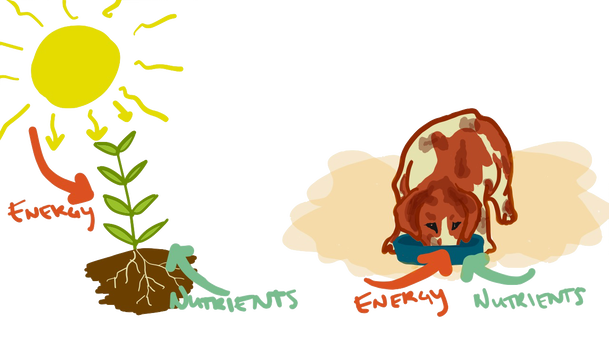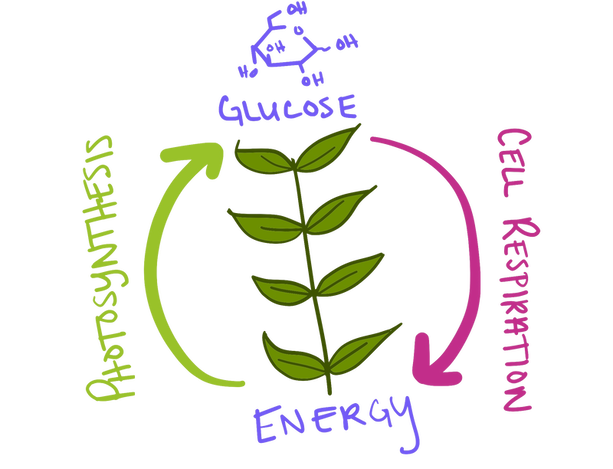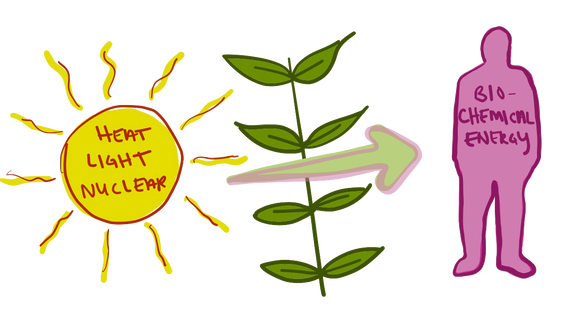Plants Get Energy From The Sun
When animals, including humans, are hungry, they eat food. Food provides both the nutrients (vitamins, minerals, building blocks like amino acids, and so on) and the energy (mostly in the form of sugars or fats) that animals need to survive. Plants are a bit different: even though they still need to take in nutrients from their environment (which they take up from soil through their roots), they are able to get energy from the sun. More specifically, they do a process called photosynthesis which converts sunlight energy into chemical potential energy (in the form of glucose). They then hold onto this glucose for later, sometimes by making starches (which they store in their roots, like potato or carrot plants), and convert that food energy into usable energy for the cell using cell respiration.
Cell respiration in plants is the same as it is in animals: glucose is gradually broken and the energy is captured along the way and used to make ATP, usable energy for the cell. The only difference is where the glucose comes from: in animals (and other things that take in glucose from the environment, like fungi, many bacteria, and most single-celled eukaryotes), glucose is eaten. In plants (and other things that do photosynthesis, like algae, some bacteria, and some single-celled eukaryotes), glucose is created using energy from the sun.
Once again, the main idea of photosynthesis is to allow plants to use energy from the sun by storing it in chemical form. But, they don’t just turn energy into matter (glucose). (Technically, it is possible to convert energy into matter, but only on the scale of the tiniest particles that make up atoms, and only with, like, a lot of energy, like in the Big Bang or in particle accelerators. Not what we’re talking about here). Instead, the sun provides the energy to convert carbon dioxide into glucose. Water helps in this process. Oxygen is released as a waste product, and comes from the water. It’s kinda funny to think of oxygen as waste since it is so vital to animal life (and because plants also need it for cell respiration), but plants really do make way more than they need! That’s great for us humans. Go plant a tree.
Here is the overall equation for photosynthesis:
Here is the overall equation for photosynthesis:
You’ll notice that the overall chemical equation for photosynthesis is exactly the opposite as cell respiration. Instead of breaking glucose down into carbon dioxide (with the help of oxygen, making water), which releases a lot of energy, we are building glucose from carbon dioxide (with the help of water, making oxygen), which requires a lot of energy. This is related to a big idea in chemistry that all reactions are technically reversible (they can go either way), but you’ll need an input of energy to go one way (in this case, photosynthesis) and you’ll get an output of energy by going the other way (in this case, cell respiration).
The actual mechanism of photosynthesis is not just the reverse of cell respiration. They’re just different processes that evolved differently and use different proteins and enzymes, and many of those enzymatic processes (even though all reactions can technically go backwards) just aren’t going to happen backwards because of energy constraints. (Reminder: enzymes are proteins that lower the activation energy for reactions, making them much faster, and in many cases, making them possible at all under biological conditions. Thanks, enzymes!). However, you will notice some similarities between the processes of photosynthesis and cell respiration. We’ll talk more about the mechanism of photosynthesis in the next sublesson.
In summary: What is photosynthesis? It is using energy from the sun to convert carbon dioxide into glucose, which stores chemical potential energy that can later be used by the cell. Or looking at the even bigger picture: It is converting sunlight energy into energy that can be used for life. (Thanks, plants!)
The actual mechanism of photosynthesis is not just the reverse of cell respiration. They’re just different processes that evolved differently and use different proteins and enzymes, and many of those enzymatic processes (even though all reactions can technically go backwards) just aren’t going to happen backwards because of energy constraints. (Reminder: enzymes are proteins that lower the activation energy for reactions, making them much faster, and in many cases, making them possible at all under biological conditions. Thanks, enzymes!). However, you will notice some similarities between the processes of photosynthesis and cell respiration. We’ll talk more about the mechanism of photosynthesis in the next sublesson.
In summary: What is photosynthesis? It is using energy from the sun to convert carbon dioxide into glucose, which stores chemical potential energy that can later be used by the cell. Or looking at the even bigger picture: It is converting sunlight energy into energy that can be used for life. (Thanks, plants!)
Summary
This video gives a great basic overview of photosynthesis and why it is important:
You should understand:
- That plants convert solar energy to chemical potential energy (in the form of glucose, which can be converted to other forms of biologically useful energy).
- That plants do both photosynthesis and cell respiration.
- That plants still need to take in nutrients.
- The overall equation for photosynthesis: plants form glucose from carbon dioxide, using energy from the sun.
Learning Activity
Contributors: Emma Moulton, Kathleen Yu, and Eli Levine




